The Jesuit Missions
7 October 2005
2:38 PM
In the decades and centuries following Columbus’s “discovery” of America, conquistadors invaded and destroyed various Latin American empires: Cortes and the Aztecs, Pizarro and the Incas, and so on. These conquests generally took place at the hands of growing European empires; they were justified by the state in the name of God and religion. (For a fascinating account of one conquest, read the narrative of Pizarro and the death of the Incan Emperor Atahuallpa in chapter three of Jared Diamond’s Guns, Germs, and Steel.) While most people know about, or at least know of these conquests, few know about the Jesuit Reductions missions that took place roughly at the same time.
The Reductions were the primary reason for our trip to Chiquitania in Santa Cruz, Bolivia. The term “Reductions” has nothing to do with a decrease in size; it is Latin for “to lead out.” In the early 18th century, the Jesuits—then a new order in the Catholic Church, today the largest—began arriving in present-day Bolivia and Paraguay. Their mission was the “peaceful civilization and evangelization” of the people there. They used techniques that seem novel in comparison with those of the conquistadors. When they arrived, the first thing they built was a school; though they left space for a church, it was the last building constructed. Since the indigenous people were involved in the construction process, the churches don’t look like miniature European cathedrals. They incorporated local styles and traditions. The interiors were ornately decorated with locally-produced art, though in the Baroque style popular in Europe at the time.
As Jesuit power in the region grew, the colonial powers in Europe (in the case of Latin America, Spain and Portugal) grew anxious. They pressured the Vatican, Pope Clement XIV suspended the Jesuit order (in 1773), and the Jesuits had to abandon hundreds of communities in Bolivia and Paraguay. (In addition to the three vows of poverty, chastity, and obedience that all non-diocesan Catholic priests make, Jesuits also make a fourth vow of obedience to the Pope, so there was no question of remaining in the missions.) When they left, European colonists burned most of the Reduction communities. A fictionalized account of this story is told in the movie The Mission.
During our trip we visited some of the remaining churches. Many were restored by the Swiss architect Hans Roth in the late 20th century; some are still active parishes today. They really are uniquely beautiful and the contain some amazing artwork. Here are a few highlights:
The tabernacle and artwork behind the altar in San Javier
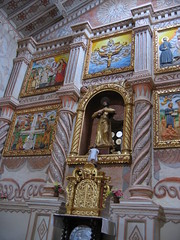
The original windows of a church. They are not made from glass but from mica.
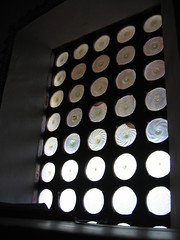
A pulpit from which lectors read and the priest gives his homily. The entire pulpit is covered with mica.
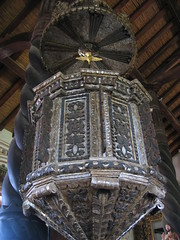
Detail of the dove suspended above the pulpit.
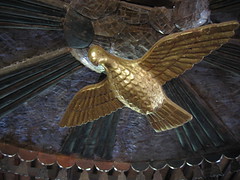
If you would like to see more pictures of these churches, I have a Flickr slideshow with my pictures from the trip.
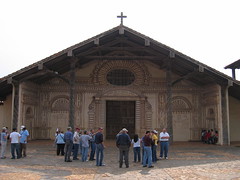
Comments